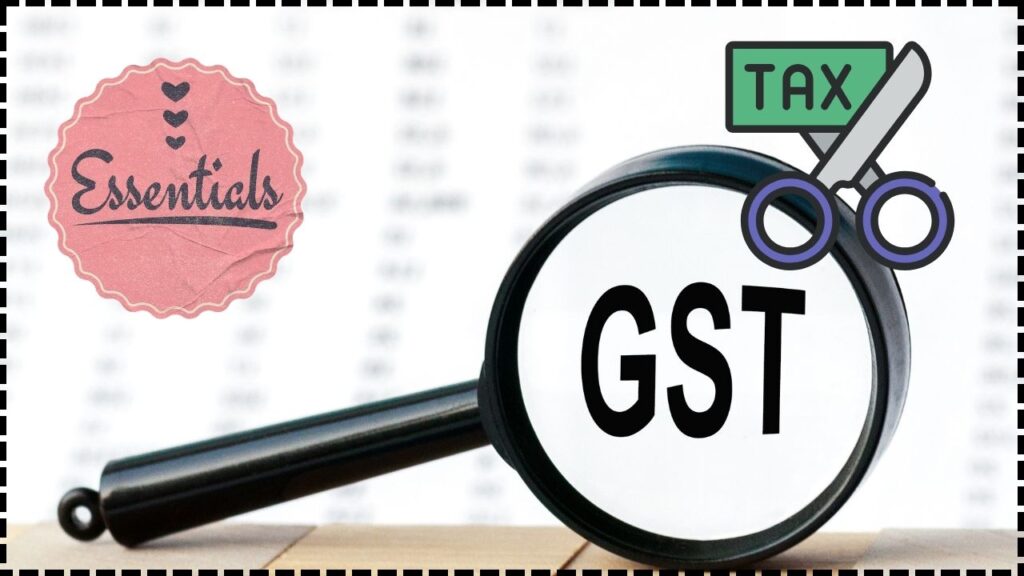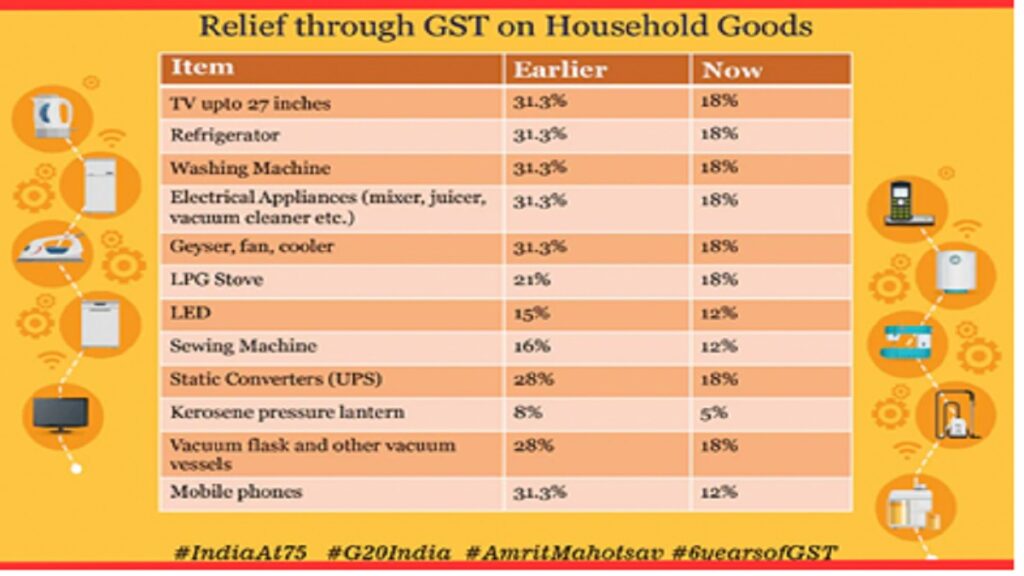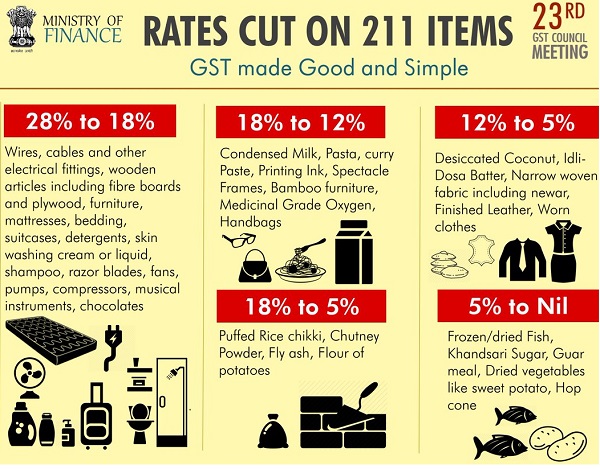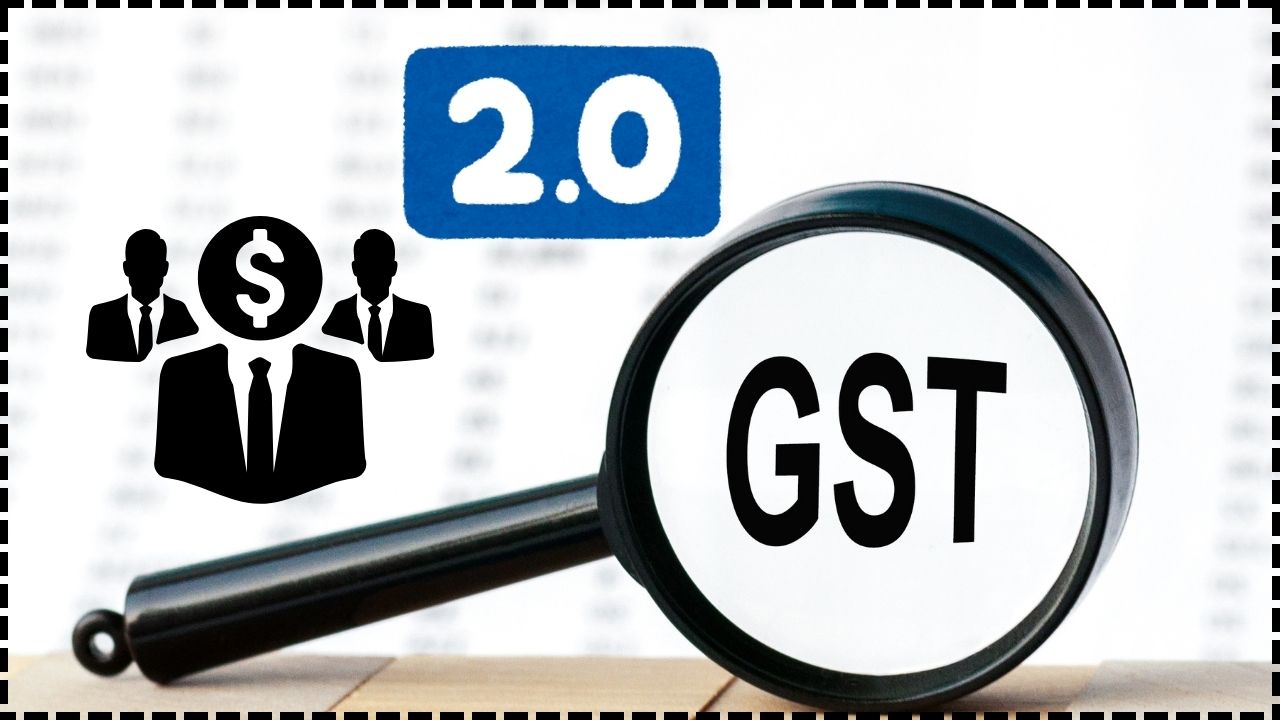
GST Slashed on Daily Essentials to 5%: In a groundbreaking move, the Indian government has announced a major reduction in the Goods and Services Tax (GST) on daily essentials, slashing rates from 12% and 18% to just 5%. This significant tax reform, which takes effect on September 22, 2025, is expected to provide much-needed relief to households across the country. For families already feeling the pinch of rising costs, this move couldn’t come at a better time. The revision includes everything from personal care products like shampoo and toothpaste, to everyday food items like biscuits, cakes, and dairy products such as butter and ghee. As the nation gears up for the festive season, these tax cuts are set to ease the financial burdens on millions, making these goods more affordable for the common man.
GST Slashed on Daily Essentials to 5%
The reduction in GST on daily essentials is a positive step toward easing the financial burdens on families. Whether you’re a busy professional, a homemaker, or a retiree, this reform aims to provide relief where it counts the most—your wallet. By making essential products more affordable, the government is supporting millions of households, improving access to goods, and boosting the economy. As we head into the festive season, this tax reform couldn’t come at a better time. You’ll be able to enjoy the festivities without the stress of rising prices. So, when you head to the store next, don’t forget to check the prices on your daily essentials—they may be a little lighter on your budget!
| Key Change | Previous Tax Rate | New Tax Rate | Effective Date |
|---|---|---|---|
| Personal Care Products (Shampoo, Soap, Toothpaste) | 18% | 5% | September 22, 2025 |
| Dairy Products (Butter, Ghee, Cheese) | 12% | 5% | September 22, 2025 |
| Packaged Foods (Biscuits, Noodles) | 12-18% | 5% | September 22, 2025 |
| Healthcare Products (Medicines, Insurances) | 12% | 5% | September 22, 2025 |
| Household Items (Utensils, Diapers) | 12% | 5% | September 22, 2025 |
What Does GST Slashed on Daily Essentials to 5% Mean for You?

Imagine waking up one morning, heading to the grocery store, and seeing lower prices on the items you use every day. That’s exactly what this new GST cut promises. For the average household, this means saving money on everything from your morning shampoo to your kid’s diapers. You might not even realize how much these costs add up over time, but a small reduction in price for everyday items can lead to major savings over the course of the year.
Let’s break down some of the most impacted sectors:
1. Personal Care Products:
Shampoo, toothpaste, soap, and even shaving creams have been hit with an 18% GST, but now, these products will be taxed at just 5%. That means fewer dollars spent on everyday essentials and more savings in your pocket for things that matter. For example, the cost of a bottle of shampoo could be reduced by ₹20-30, depending on the price.
Personal care products often have high usage rates in families. Parents, for example, buy baby shampoo or diaper creams regularly, and with the GST drop, this will make these essential goods less financially taxing. More affordability means more consumption, which in turn helps local businesses. Many manufacturers are expected to pass on the cost savings to customers, making the entire sector more competitive.
2. Dairy Products:
For many households, butter, ghee, and cheese are staples that make meals complete. These items, which previously had a GST of 12%, will now be taxed at just 5%. This change will be particularly helpful for families who use dairy products regularly, cutting down grocery bills. Not only that, but items like paneer and roti (Indian bread) have seen a massive benefit—they will be completely exempt from GST, a boon for many Indian families who consume these foods daily.
Dairy products are an important part of a balanced diet, especially in traditional Indian meals. Cutting costs on these products will have a wide-reaching impact, not just on family budgets but also on consumption patterns across the country. With this significant reduction, families may be encouraged to buy higher quantities, leading to an increase in consumption and better nutrition for households.
3. Packaged Foods:
Biscuits, cakes, chocolates, jams, noodles, and ready-to-eat meals are often go-to snacks for busy families. Previously taxed at either 12% or 18%, these products will now fall under the 5% GST category, making them more affordable, especially for those with children or those who rely on packaged foods for convenience.
These products are staples in many households, particularly during busy school days or as snacks after work. The lower tax rates will benefit not only households but also businesses in the packaged food industry, which may see a rise in sales as consumers are drawn to the more affordable options. Additionally, families will likely see long-term savings as they continue to purchase these items regularly.
4. Healthcare Products:
Perhaps one of the most important changes involves healthcare-related goods. Medical devices like thermometers, glucometers, and even life-saving health insurance policies will now be taxed at a much lower rate or even exempted completely. This reduction could allow more people to access essential medical services and improve the affordability of health insurance.
In the wake of rising healthcare costs, this tax revision could prove to be crucial. Lower healthcare product prices will provide financial relief to those who are already struggling to afford basic medical devices and insurance policies. As medical equipment is now taxed at just 5%, this will also likely encourage greater investment in health-related products, resulting in improved public health outcomes.
5. Household Items:
From kitchen utensils to baby care products like diapers and feeding bottles, everyday household items will see a substantial reduction in GST. Items that were once taxed at 12% are now reduced to 5%, putting more money back into family budgets.
Families with young children will particularly feel the benefit of this change. Diapers, baby wipes, and feeding bottles are used constantly, and any reduction in cost will be felt almost immediately. Similarly, household utensils, which are part of every family’s kitchen inventory, will become more affordable, easing the financial strain for everyday consumers.

Why This GST Reform Is So Important?
For many years, the GST rates on essential goods were relatively high, which created a financial burden for families, especially those in the middle or lower income brackets. Everyday essentials that families use—like food, personal care items, and baby care products—often come with a hefty price tag because of taxes.
Now, the government’s decision to slash these taxes could be a game changer. It directly impacts the wallets of millions of families who were struggling with increased living costs. The new GST reform aims to:
- Make essential goods more affordable: As taxes come down, so do the prices of many household goods. Whether you’re buying shampoo or bread, you’ll notice the change.
- Boost consumer confidence: For low-income and middle-class families, this tax reform will feel like a financial breather. It encourages spending, especially ahead of festive seasons like Diwali and Navratri when families tend to buy more.
- Drive economic growth: By reducing the prices of everyday goods, the government expects a surge in demand. More affordable goods translate into more consumption, which can positively impact businesses and industries, leading to growth.
By slashing the GST on such widely used items, the government is making an effort to ensure that the benefits of growth and prosperity are shared across all sectors of society, especially benefiting those who need it the most. The move is likely to have a ripple effect across various industries, driving demand for both essential products and services.

The Economic Implications: How Will Businesses and Manufacturers Respond?
While the direct benefits to consumers are clear, the impact on businesses and manufacturers is also significant. Companies in the FMCG sector, which deal with daily essentials, will benefit from increased demand as products become more affordable.
- FMCG Sector Growth: With the prices of commonly consumed goods coming down, more people are expected to buy these products, leading to higher sales for FMCG companies. These companies will likely see their profits increase, as the demand for lower-cost essentials like shampoo, milk, biscuits, and more goes up.
- Supply Chain Recalibration: Manufacturers and retailers will need to recalibrate their supply chains to reflect the new GST rates. This means adjusting pricing strategies and stock levels to meet the expected increase in consumer demand. Retailers will likely pass the tax cuts on to consumers, helping businesses retain customer loyalty and strengthen their brand image.
- Regional Economic Benefits: Local businesses, particularly those in smaller towns and rural areas, will also benefit from the reduced tax rates. Lower prices could spark more consumer spending and help stimulate local economies, especially during festive periods when consumption peaks.
India Plans GST Cuts On Hybrid Cars And Electronics
Big GST Cuts, But Who Really Benefits? Profiteering Worries Raise Red Flags
Will Modi’s GST Reforms Tame Inflation and Push RBI Toward Cuts?










